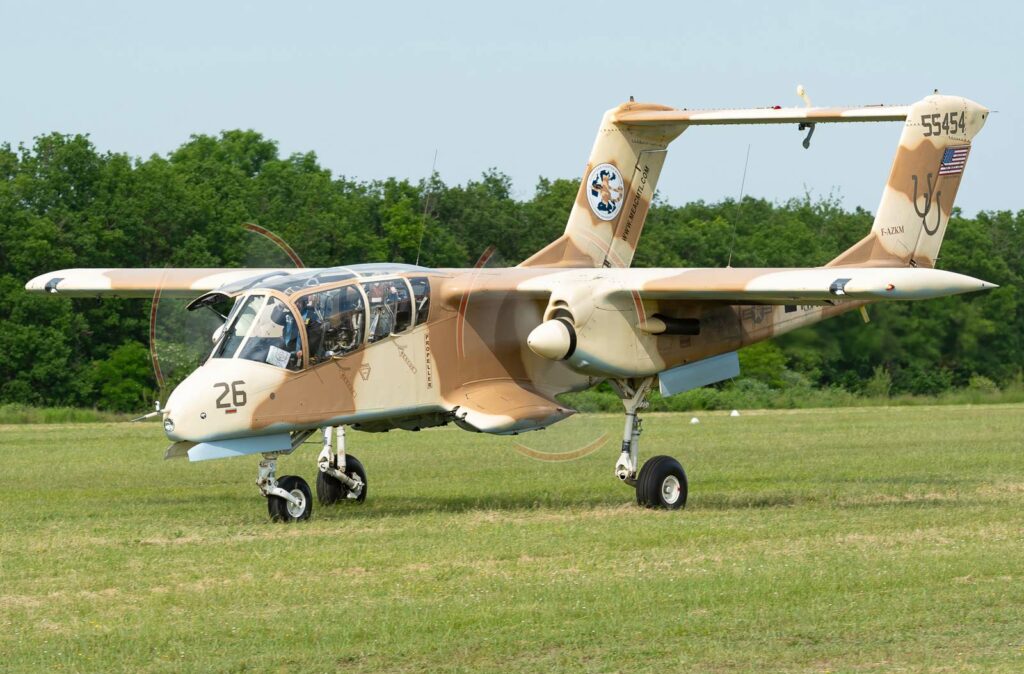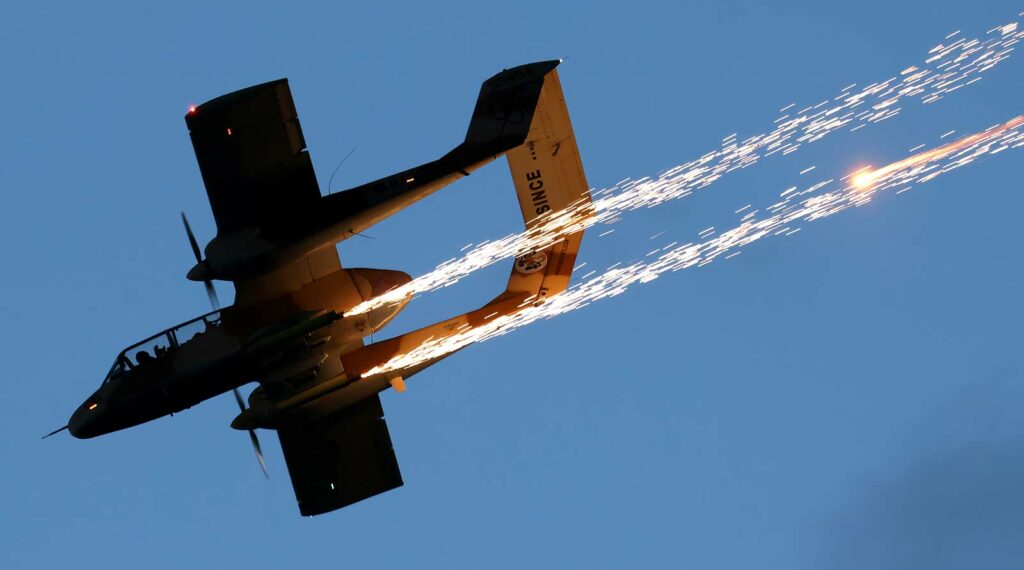The OV-10 Bronco is a versatile twin-turboprop light attack and observation aircraft, known for its superb maneuverability and STOL capabilities.
In brief
The North American Rockwell OV-10 Bronco is a rugged, twin-engine turboprop aircraft designed for light attack, reconnaissance, and forward air control (FAC) missions. Introduced in the 1960s, it features a distinct twin-boom layout, short takeoff and landing (STOL) capabilities, and high maneuverability. The OV-10 was engineered to operate from austere environments and improvised airstrips, supporting close air support (CAS), combat observation, and target designation. Equipped with a variety of armaments, including machine guns, rockets, and external bomb loads, the Bronco also offers exceptional visibility from its tandem cockpit, making it ideal for observation and light strike roles.
The North American Rockwell OV-10 Bronco holds a unique position in military aviation history, bridging the gap between light observation aircraft and heavier attack aircraft with its versatile operational capabilities.

History of the Development of the North American Rockwell OV-10 Bronco
In the early 1960s, the U.S. Navy initiated the Light Armed Reconnaissance Aircraft (LARA) program, seeking a new aircraft for counter-insurgency (COIN) operations, reconnaissance, and forward air control. The need was for an aircraft that could perform well in rugged conditions, offer excellent visibility, carry a significant payload, and operate from short, unprepared runways. North American Rockwell’s OV-10 Bronco, first flown on July 16, 1965, was the response to this requirement, designed to excel in close air support, aerial reconnaissance, and utility roles.
The OV-10 Bronco was a product of its time, conceived during the Vietnam War when the U.S. military sought versatile and durable aircraft for various unconventional warfare tasks. Its development was influenced by the growing necessity for improved aerial observation and light attack capabilities, optimized for guerilla warfare conditions where conventional fast jets and helicopters were less effective.
Design of the North American Rockwell OV-10 Bronco
The OV-10 Bronco’s design is characterized by its distinctive twin-boom layout, which accommodates a rear cargo compartment, and its high-mounted wings for excellent visibility and ground clearance. The aircraft is powered by two Garrett AiResearch T76-G turboprop engines, providing a balance of speed and endurance, while its rugged construction allows operations in harsh environments.
The Bronco’s cockpit, designed for a pilot and an observer, offers panoramic visibility, crucial for reconnaissance and forward air control missions. The aircraft’s STOL capabilities are complemented by its large, straight wings, which provide lift and low-speed handling that are essential for its varied mission profile. The aircraft was also designed with a fuselage-mounted sponson on each side, housing weapons stations and additional fuel when necessary.
The versatility in its design allowed for modifications to be made for specific missions, including the addition of infrared and electronic countermeasure equipment, making the OV-10 a multi-role aircraft capable of adapting to various operational requirements.
Performance of the North American Rockwell OV-10 Bronco
With its twin-turboprop engines, the OV-10 Bronco has a maximum speed of about 281 mph and a range of over 1,000 miles, depending on its loadout and mission profile. Its service ceiling reaches approximately 26,000 feet, allowing for effective reconnaissance and light attack missions at various altitudes. The aircraft’s STOL capabilities enable it to operate from short and rudimentary airstrips, enhancing its utility in forward-operating bases and austere environments.
Comparatively, the OV-10’s performance in the light attack and observation roles was superior to other aircraft of its time, providing a unique combination of speed, endurance, and payload capacity that was particularly valuable in counter-insurgency and close air support missions.
Variants of the North American Rockwell OV-10 Bronco
The OV-10 Bronco series includes several variants:
- OV-10A: The initial production model used by the U.S. military.
- OV-10B: A target-towing variant developed for the German Air Force.
- OV-10C: A version exported to Thailand with specific modifications.
- OV-10D: An upgraded version with improved sensors, armament, and night-capable avionics.
- OV-10E/F: Export versions for Venezuela and Indonesia, respectively.
Each variant was tailored to meet the specific needs of its operators, with modifications affecting avionics, armament, and performance characteristics.

Military Use and Combat of the North American Rockwell OV-10 Bronco
The OV-10 Bronco saw extensive service in Vietnam, where it was used for forward air control, light attack missions, and reconnaissance. Its ability to mark targets accurately, direct air strikes, and assess damage post-strike made it invaluable. The aircraft’s combat history includes participation in Grenada (Operation Urgent Fury), Desert Storm, and more recently, in counter-insurgency operations against ISIS, showcasing its enduring utility in modern warfare.
Despite facing competition from newer aircraft over time, the OV-10’s unique capabilities have ensured its continued use in various roles, including counter-drug operations, firefighting, and as a test platform for new technologies.
Technical Conclusion
The North American Rockwell OV-10 Bronco represents a significant advancement in military aviation, specifically in the realms of light attack and observation. Its innovative design, versatility, and robust performance have solidified its status as a valuable asset in a wide array of military operations, proving that the Bronco’s unique capabilities continue to serve modern warfare requirements effectively. Its legacy endures as a testament to its significant contributions to military aviation history.
Back to the Special Aircraft section